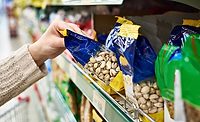SÜDPACK Expands Sustainable Print Quality to Include Rotogravure Printing Suitable for Food

Image provided by SÜDPACK
Reducing ink and solvent consumption while simultaneously optimizing print quality, SÜDPACK’s SPQ technology for flexo printing offers potential carbon savings for package printing. Now, SÜDPACK has expanded the range of use for the innovative printing process to also include rotogravure printing, offering an alternative that is highly efficient and conserves resources.
Using the technology for rotogravure printing requires the complete standardization of machine and process parameters, as well as smart color management. Just like for flexo printing, all of the designs are mapped automatically in the pre-press stage using a reduced color palette.
Thanks to the PUR-based (polyurethane) color system, the ink is also suitable for pasteurization and sterilization. This opens up a wide variety of options for applications that involve heating, such as for packaging ready-to-eat (RTE) meals, pet food, or baby food. The technology is also ideal for finishing flexible films for high-quality, fast-moving consumer goods, such as coffee, tea, or confectionery, because it can also incorporate metallic colors and coatings for texture and other finishes. The process is also suitable for imprinting Digimarc digital watermarks.
Using SPQ can significantly reduce the carbon footprint of package printing, due to the reduction of the standard color palette from ten to just seven colors, which decreases both ink and solvent consumption. In-house calculations performed by SÜDPACK have shown that limiting the palette to seven colors leads to a savings of approximately 36.5 percent in a typical standard process for a print order for 15 thousand running meters.
Additional factors in terms of sustainability include lower energy consumption and the reduction of film waste that would have usually been produced during the changeover of printing machines for the next print order.
SÜDPACK customers also benefit from the reduced amount of effort required in the pre-press stage. Using a strictly defined color space eliminates not only constant color adjustments, but also complex and costly onsite print approval. An additional advantage is that different print designs can be combined in one print order.
Finally, the new technology stands out due to its high register accuracy, as well as its outstanding color consistency and color brilliance. This is thanks to consistent, smart color management along the process chain. The standardized color palette can create approximately 95 percent of all Pantone colors, and does so with stable, reproducible color conversion. As a result, SPQ completely eliminates all of the adjustments necessary for conventional printing processes.
SÜDPACK: www.suedpack.com
Looking for a reprint of this article?
From high-res PDFs to custom plaques, order your copy today!






